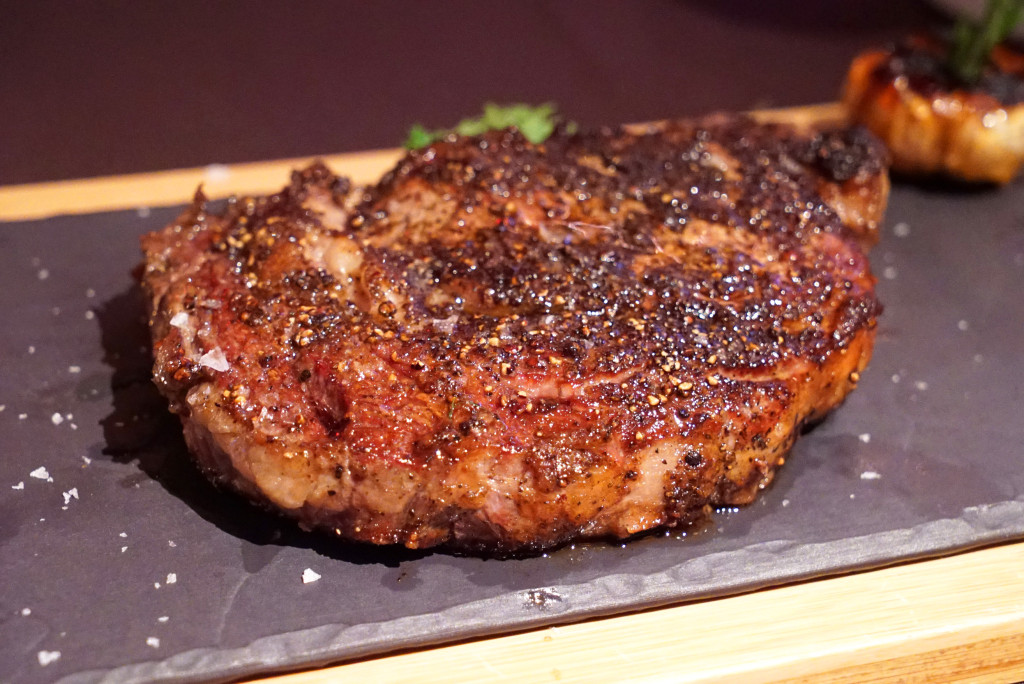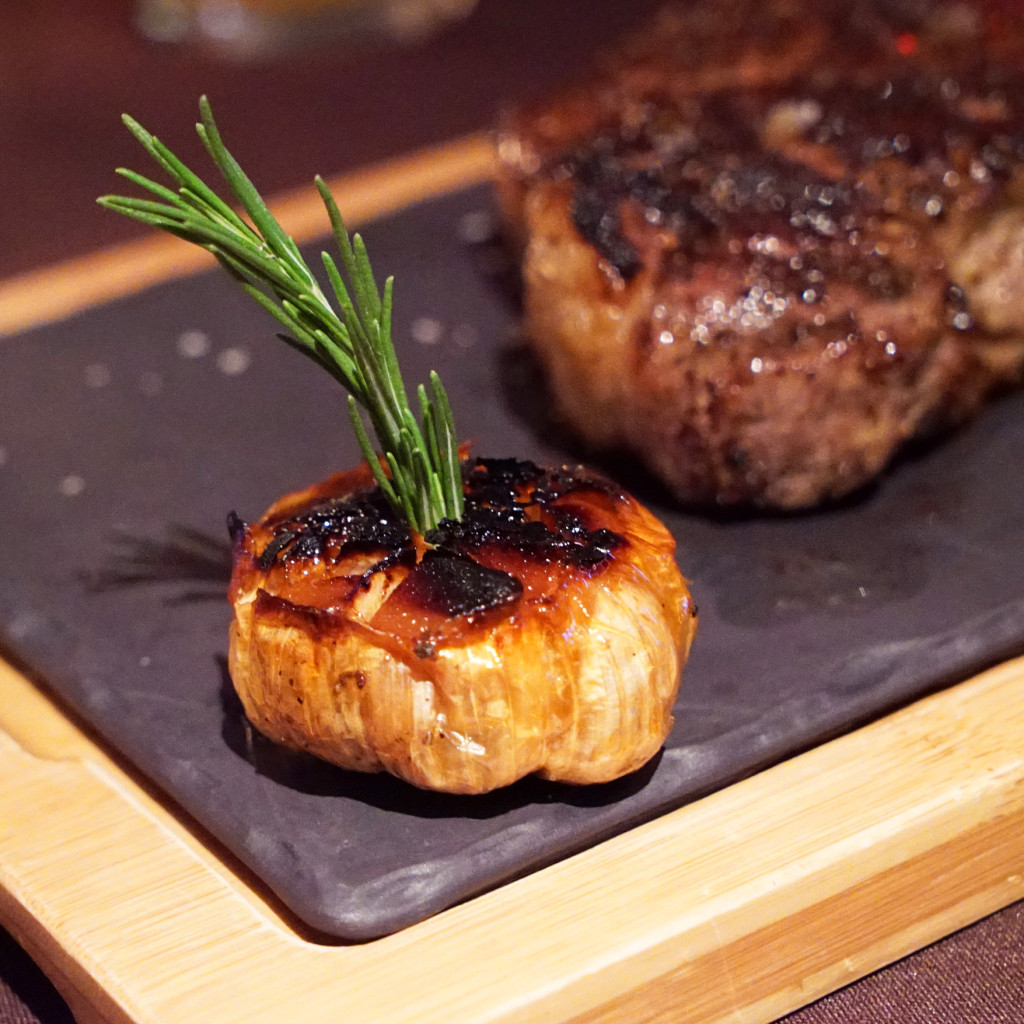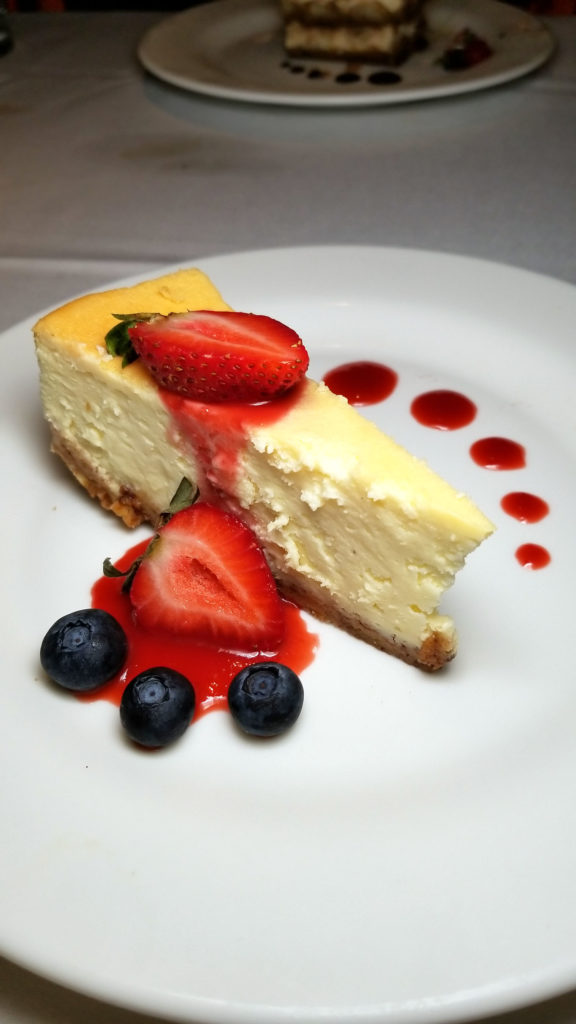Lots of people ask me about aged beef, and whether an aged steak is worth the upcharge at a restaurant or butcher shop. The simple answer is yes. But if you’re like me, you also want to know why it’s worth the money, and how beef aging happens. I’ve got you covered here. This page should serve as your guide to convincing yourself to seek out and eat aged beef more often.
Let’s first start with the fact that there are two major, most common types of aging techniques employed by most meat people: Dry Aging and Wet Aging.

Dry Aging
After the animal is slaughtered and cleaned, large format cuts with high, evenly distributed fat content are placed in temperature- and humidity-controlled coolers. The reason I say “large format cuts” is to separate out in your minds the idea that you can just toss a grocery store cut of steak into an aging box and let it go. That would be wasteful, as your steak will shrink during the aging process. So instead, meat purveyors will use something big, like a full standing rib roast, or even an entire side of beef when they dry-age meat.

Dry-aging processes tend to cause the meat to desiccate to the point where you can lose almost a third of the original weight. So if you’re starting with many pounds of meat, typically untrimmed of any fat and still having the bones in, then it doesn’t hurt so much when your beef loses some weight and eventually gets trimmed. The reason I say “high fat content” is because fat equals flavor, and dry-aging increases and concentrates flavor. During the process, that fat content also becomes very tender, and acts like butter when it gets rendered out during cooking.
The coolers or “aging boxes” can vary greatly. They can be large aging rooms or just a mini-fridge sized unit that has been modified to stay at near-freezing temperatures with good air circulation and lowered humidity.

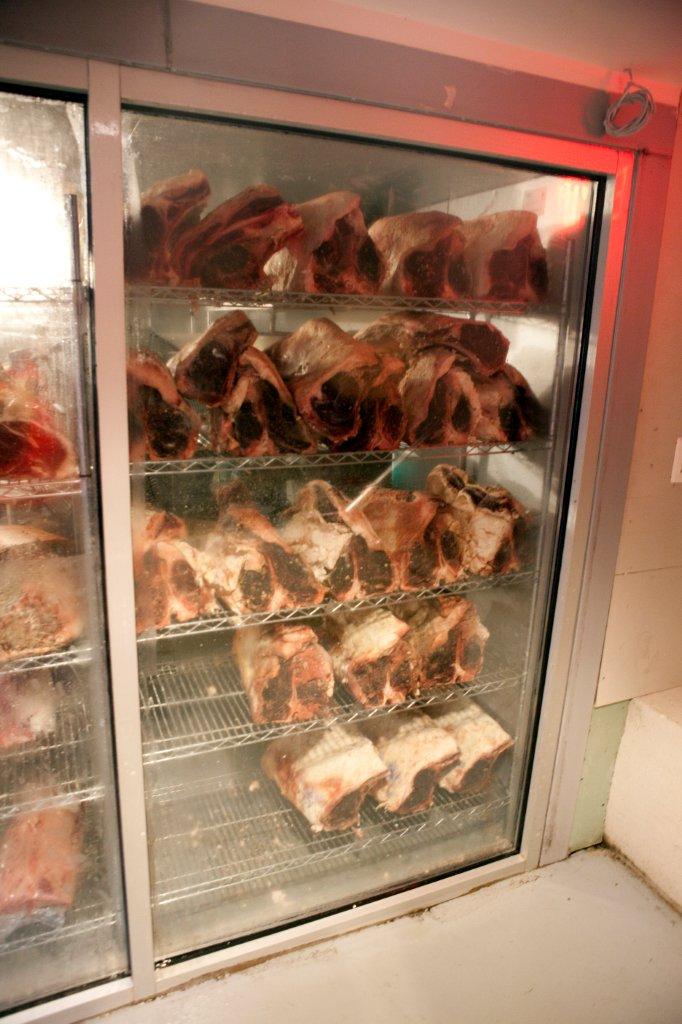
The beef must be stored at near-freezing temperatures, and with a somewhat lowered humidity. Right off the bat, these steps eliminate the prospect of having to combat certain harmful bacteria that can only survive above a certain temperature with certain levels of humidity. Air circulation, air ventilation and even UV lighting are also key in these cold-boxes, as they further help to prevent certain types of harmful bacteria from forming while promoting other, more helpful bacteria and fungi.
“Bacteria? Fungus? Eww!”
Nope. Don’t be an asshole. Here’s how it works: Dry-aging promotes growth of certain fungal mold species on the external surface of the meat. This doesn’t cause spoilage, but actually forms an external “crust” on the meat’s surface, which is trimmed off later, when the meat is prepared for cooking. These fungal species complement the natural enzymes in the beef by helping to tenderize the meat, and enhancing and increasing the flavor of the meat. The natural enzymes in the beef break down the proteins, making everything more soft and tender.
Once the aging is completed, the dark, thick and hardened bark on the outside is trimmed away from the underlying softened meat. This bark will form on any outer portions of the meat that are in contact with the air.



Bark is good. Dry-agers WANT that bark all around the meat. For that reason, meat within the cooling box will almost always be placed on a metal rack – which allows for air flow underneath – rather than a solid, flat surface. This also prevents bad bacteria from forming underneath the meat where it rests on the surface.
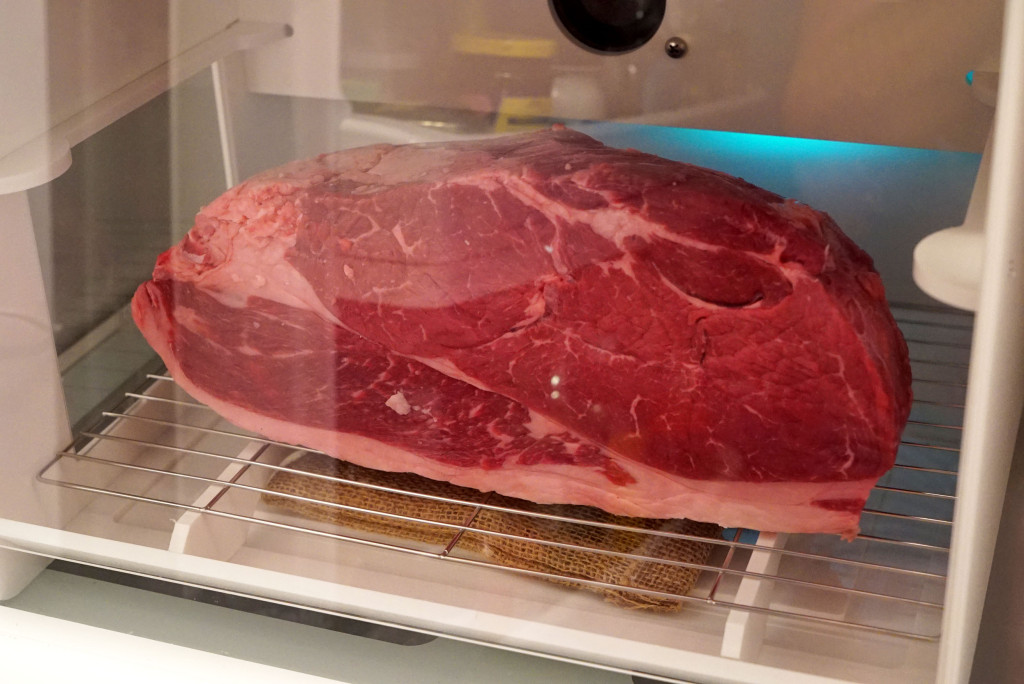
“So why even do all of this? I’m still kinda grossed out about the bacteria and fungus.”
Then you should eat a dick instead of a steak. But seriously: The beef’s natural enzymes will break down the fat and connective tissue within the muscle, which increases the meat’s tenderness. And since moisture is evaporated from the muscle as well, you get a greater concentration of beef flavor and taste in the end-product.
“But why would I want a dry steak? Isn’t a great steak supposed to be very juicy?”
Finally a good question. The steak doesn’t get THAT dry, and the majority of the real dryness is on that outside bark that you trim away. The meat still retains about 2/3 of its moisture, and that translates directly to “juiciness” while minimizing bleed-out after cooking. Once you start to cook the steak, tons of juices will begin to flow – trust me. So why do all of this? To sum up: the dry-aging process changes and improves beef in two ways: (1) it increases tenderness, and (2) it concentrates and enhances flavor.



Length of Dry-Aging
Dry-aging is commonly done for 15–28 days, but it is sometimes purposely done for longer periods of time. More time results in more shrinking, but also more flavor. Sometimes aged beef can take on a nutty flavor quality, intense earthiness, or the funk smell of blue cheese. A good number that I frequently see in restaurants is 35-days. At that point you are getting some of those interesting flavors without it being too overwhelming to the average consumer. Then again I have had 62-day steak that had a much more funky flavor quality than other 85-day, 105-day and 120-day steaks that I’ve tried. So I guess it depends on cooking technique too.
Availability
One seldom sees dry-aged beef outside of steakhouses, restaurants and upscale butcher shops. It is rare to see it in grocery stores due to the significant loss of weight in the aging process. Grocery stores sell meat by the pound and most average folks won’t understand the appeal of a funky, crusty and rotten looking piece of reddish-brown meat at such a marked-up price point. Most people just want to grab their pre-packaged steaks for the grill, and that’s fine. Only a few of us would be looking for top notch stuff like this. Whole Foods does offer aged beef, and they even age it on-site at their butcher counters. But dry-aged steaks are almost as expensive raw at a supermarket as they are fully cooked by experts in a steakhouse. So for this kind of stuff it makes sense to just go to the restaurant, or man-up and do it at home yourself.
An Important Tip
Home cooks beware: Dry-aged beef cooks very fast because it is more dry than a regular steak. I like to re-hydrate mine with olive oil. I let it soak for a while in an olive oil and garlic bath at room temperature before I cook it. Another option is to sous vide it in a butter-filled vacuum pack to about 120 degrees first, and then finish it off with a hard sear in an iron skillet for a nice crust on the outside.
Wet Aging
Wet-aged beef is beef that has typically been aged in a vacuum-sealed bag to retain its moisture. This is the dominant mode of aging beef in the United States today, and you’ve most likely eaten wet-aged beef without even being aware. Wet-aging is popular because it takes less time (typically only a few days to a couple of weeks) and none of the weight is lost in the process (because there is no desiccation). For that reason, one can age individual cuts of steak rather than large format chunks of beef.
With the advent of plastics and vacuum sealing technology, meats can be broken down at the slaughterhouse, packed up, vacuum sealed and shipped out to grocery stores, butcher shops or restaurants. Since the meats are vacuum sealed rather than hung up in a cold dry locker during transport, the wet-aging will happen during the length of time it takes for a truck to deliver the product.
In the wet-aging process, natural enzymes do all the work to break down and tenderize the beef; there is no mold, bacteria or fungal growth aiding in the process or altering flavors.
I’ve only eaten wet-aged beef a few times at steakhouses in all of my steaking days. I don’t notice that much of an improvement, and I generally tend to enjoy dry-aged steaks more because of the concentrated and funky flavors. However, like the choice between a porterhouse and a rib eye, this is largely a matter of personal preference. Some people don’t like the texture or flavors associated with dry-aged beef, so they will stick to the wet-aged stuff.
Alternative Aging Techniques
So that covers the two major methods for aging beef. But there are other ways to achieve the same if not similar flavor characteristics.
Aging Bags
Umai Dry and other companies offer special, large semi-vacuum seal-able bags that mimic the dry-aging process pretty closely. I’ve tried these out and really enjoyed the outcome. Simply put, you seal up the meat according to their instructions, and place on a metal rack in your fridge. Then you wait, and once the aging is complete, you carve off all the bark and portion everything out into individual steaks for cooking.

Koji Rice Method
I recently came across an article that lit up my brain synapses like wildfire. As you may know, the Japanese are masters at fermentation. They’ve been fermenting soy, miso and other delicious items for centuries with great success. In fact they’ve been credited for the 5th flavor sensation, “umami,” which I call earthiness or funk. Think aged hard cheese, dashi broth, soy sauce, mushrooms, truffles or fish sauce. These items have distinct and almost dank smells and flavors, but in a good way that invigorate your taste buds. Lots of the flavors in these items, specifically the soy and miso products, are created due to the presence of a live bacterial culture that breaks down proteins, similar to what happens during the beef aging process. The Japanese have harnessed this bacteria and introduced it into sacks of Koji rice grains for their fermentation purposes. This rice is available all over the place.
So basically a guy grabbed a cut of steak and dusted it with some powderized Koji rice, and in two or three days he had a steak with the flavor characteristics of dry-aged beef. Now, he did this on a pre-cut and pre-portioned steak, so he was limited with the time he could age it. If he went any longer, the steak would have started to desiccate too much and he wouldn’t have been left with much meat after having to carve off the outer bark. Rice will absorb moisture, after all, and leech out moisture. In fact, the end result might be more like a cured meat that was packed with salt (like prosciutto) rather than a dry-aged steak.
In any case, I will probably give this a whirl at some point soon, so keep your eyes peeled for updates.
Additional Useful Information
Because I am thorough and anticipating your thoughts and questions, here is some more shit:
Aging Other Types of Meats
Why, yes, you can age other kinds of meats like chicken, pork or lamb. However, since these are smaller animals, you tend to lose a lot of their weight during the dry-aging process. For that reason, anyone doing this with non-beef will likely age the meat for shorter amounts of time than beef counterparts. Furthermore, I would imagine you’d have to be even more careful and mindful of harmful bacteria, as chicken and pork could have a higher occurrence of bad bacteria in their flesh than beef (salmonella, trichinosis, etc) if certain conditions are not sanitary from the outset. As with beef, wet-aging is possible with vacuum sealing.
Difference Between Aging and Curing
Curing is the process of preserving meats with the addition of salt, sugars, nitrites or nitrates. These things are not added to beef in the aging process. The addition of these materials eventually creates a completely inhospitable environment for bacteria, and therefore the meat will not easily spoil, even at room temperatures. This is not the case with aging. Moisture is still retained, even with dry-aging. So if removed from an aging cooler a dry-aged steak will eventually spoil. Examples of cured products include various charcuterie meats that we all know and love, like salami, pepperoni and prosciutto.
Sometimes meats are cured and preserved by smoking as well. Jerky is also a form of meat preservation that involves both heat and drying, but not curing.

Since cured and dried meats deserve their own write-up on this website, I will eventually be adding a page dedicated to them here in time. Keep your eyes out for that.



